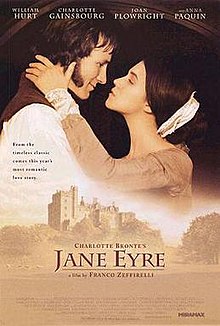Jane Eyre (1996 film)
| Jane Eyre | |
|---|---|
 Theatrical release poster | |
| Directed by | Franco Zeffirelli |
| Written by | Hugh Whitemore Franco Zeffirelli |
| Based on | Jane Eyre by Charlotte Brontë |
| Produced by | Dyson Lovell |
| Starring | |
| Cinematography | David Watkin |
| Edited by | Richard Marden |
| Music by | Claudio Capponi Alessio Vlad |
| Distributed by | Warner Bros. (France)[1] United International Pictures (Italy and Hungary)[1] Guild Pathé Cinema (United Kingdom)[1][2] Miramax Films (United States) |
Release date |
|
Running time | 116 minutes |
| Countries | France Italy United Kingdom United States |
| Languages | English French |
| Box office | $5,200,601[3] |
Jane Eyre is a 1996 romantic drama film adaptation of Charlotte Brontë's 1847 novel Jane Eyre. This Hollywood version, directed by Franco Zeffirelli, is similar to the original novel, although it compresses and eliminates most of the plot in the last quarter of the book (the running away, the trials and tribulations, new-found relations, and new job) to condense it into a 2-hour movie.
Plot[]
Jane Eyre (portrayed as the orphan child by Anna Paquin and as an adult by Charlotte Gainsbourg) is a plain, impoverished young woman hired by Mr. Rochester (William Hurt) through Mrs. Fairfax (Joan Plowright) to work as a governess for Adèle (Josephine Serre). Despite her mild unprepossessing nun-like manner, Jane has strong hidden passions and shows her strong character by expressing her opinions and showing resolve in times of trouble. Rochester is a Byronic anti-hero, tortured and tormented by family troubles, past injustices and secrets. Rochester and Jane develop a mutual affinity. They fall in love and the marriage date is set. What Jane does not realize is that she must share the estate and, ultimately, Mr. Rochester with his wife, Bertha (Maria Schneider), who is mentally ill and is confined in an upstairs attic with a nurse, Grace Poole (Billie Whitelaw).
The marriage is stopped by Bertha's brother Richard Mason (Edward de Souza) and lawyer Briggs (Peter Woodthorpe). Jane flees her world in ruins. She recovers in the parsonage, her aunt's original home, and discovers she is now wealthy through inheriting her long-lost uncle's fortune in Madeira. She receives a proposal of marriage from Parson St. John Rivers but her heart and soul is with Rochester. Jane goes back to find Rochester's house, Thornfield Hall, burnt down and Rochester crippled and blinded by a fire set by Bertha, who perished. However, Jane's love for Rochester is undiminished; she nurses him back to health, he recovers his eyesight and they marry.
Cast[]
- Charlotte Gainsbourg as Jane Eyre
- William Hurt as Edward Fairfax Rochester
- Fiona Shaw as Mrs. Reed
- John Wood as Mr. Brocklehurst
- Geraldine Chaplin as Miss Scatcherd
- Amanda Root as Miss Temple
- Leanne Rowe as Helen Burns
- Richard Warwick as John
- Joan Plowright as Mrs. Fairfax
- Judith Parker as Leah
- Josephine Serre as Adèle Varens
- Billie Whitelaw...Grace Poole
- Elle Macpherson as Blanche Ingram
- Julian Fellowes as Colonel Dent
- Edward de Souza as Richard Mason
- Peter Woodthorpe as Briggs
- Ralph Nossek as Reverend Wood
- Maria Schneider as Bertha Mason
- Samuel West as St. John Rivers
- Charlotte Attenborough as Mary Rivers
Production[]
The location for Thornfield Hall is Haddon Hall, Bakewell, Derbyshire, UK[4] Since Zeffirelli's use of Haddon Hall, subsequent versions of Jane Eyre have used it and it is now apparently synonymous with Thornfield Hall. Prior to Zeffirelli's location use, Haddon Hall had been once used (before Jane Eyre) as the castle for The Princess Bride.
Reception[]
The film holds a positive rating of 74% at Rotten Tomatoes based on 27 reviews.[5] The New York Times called Hurt "embarrassingly miscast as a Rochester more nearly a mild eccentric than a brooding, Byronic type", but conceded that the film "has its moments".[6]
References[]
- ^ Jump up to: a b c "Jane Eyre (1996)". UniFrance. Retrieved 17 August 2021.
- ^ "Jane Eyre (1996)". BBFC. Retrieved 17 August 2021.
- ^ "Jane Eyre (1996) (1996) - Box Office Mojo". Box Office Mojo. Retrieved 13 February 2011.
- ^ Haddon Hall Archived 2010-05-02 at the Wayback Machine at Astra Brit Flick Pilgrimage, Visit Britain.com . Accessed July 2011
- ^ "Charlotte Bronte's Jane Eyre (1996)". Rotten Tomatoes. Retrieved 13 February 2011.
- ^ McGrath, Charles (2011-03-04) Another Hike on the Moors for ‘Jane Eyre’, New York Times
External links[]
- 1996 films
- American films
- British films
- English-language films
- English-language French films
- French films
- Italian films
- Films based on Jane Eyre
- Films directed by Franco Zeffirelli
- Films about nannies
